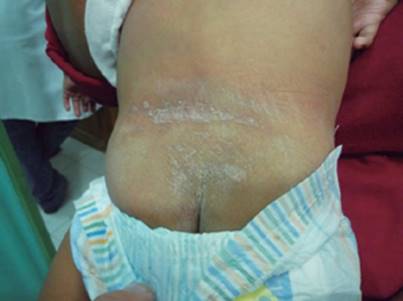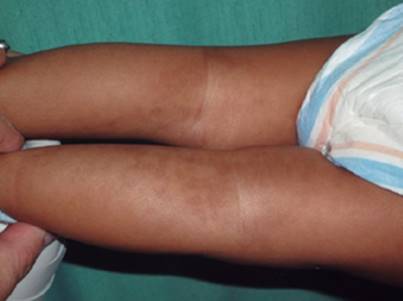In 2013 a cross-sectional study revealed 28 cases of active syphilis in 219 women deprived of liberty (WDL) in a prison in Cochabamba, Bolivia. Congenital syphilis (CS) was assessed in children living with infected mothers.
Clinical case number 1. The mother of “child A” was diagnosed with syphilis upon delivery. The newborn (NB) initially did not present symptoms compatible with CS. The NB initiated treatment with crystalline penicillin G for ten days. It was also found that under 40% of the prescribed doses were actually delivered to the child. The mother reported that when the child was around 7 weeks old he started presenting rhinitis and a diffuse rash. Figures 1 and 2 depict the lesions at three months. The red blood cell (RBC) count together with the white blood cell (WBC) count, platelets and transaminases were within the normal parameters. FTA-ABS IgM was positive but the RPR test and the FTA-ABS test were negative (bio-Mérieux, France).
Clinical case number 2. The mother of “child B” was diagnosed with syphilis two months before delivery with an unknown time of progression (probably over one year) and received incomplete treatment with penicillin (G sodium 600,000 IU and benzathine 1,200,00 IU im, for two subsequent days). The NB initially did not present symptoms compatible with CS and thus received no treatment for CS. When the child was two months old, the mother reported a diffuse rash. Figures 3 and 4 depict the lesions at 11 months of life. Despite slight anemia of HB 9.2 g/dl (10.5-14), the WBC and platelet count, together with transaminases were within range. All FTA-ABS IgM, RPR (1:8) and FTA-ABS tests were positive (bioMérieux, France). Both children were referred to hospital for treatment after being detected.
Discussion. The risk for vertical transmission of syphilis ranges between 10 and 100%, decreasing as the mother’s disease progresses1. To detect CS, treponemal and nontreponemal tests are suboptimal for newborns. False positive results can occur in NB due to the transmission of IgG antibodies to the fetus1. False negative results are not uncommon in early infections. In “child A”, the low level of RPR in the mother could have also explained the negative results for the RPR and FTA tests2. However, since IgM antibodies can not cross the placenta, the FTAABS IgM test confirms the diagnosis of CS in both children2.
Cutaneous manifestations are present in over two thirds of the cases of early CS3,4 and are most commonly developed between the second and the eighth week of life4, as in the two cases reported herein. These usually start as small blisters on the soles, the back and the back of the thigh (Fig 1-2-3), later changing to persisting copper-colored flat or bumpy rash2 (Fig.4). Other symptoms in NB include anemia and rhinitis (present in one of the cases), hepatosplenomegaly, periostitis and/or osteochondritis, neurosyphilis, leukocytosis and thrombocytopenia3,4.
The treatment of syphilis is low cost and effective3: it controls early manifestations and prevents late manifestations which can be deadly. Despite treatment being considerably easy to undergo, mistakes should be avoided (as in the two cases reported). CDC and WHO guidelines recommend three doses of benzathine penicillin (2.4 million IU IM once a week for syphilis in adults of over a year or for unknown evolution of the disease)3. The treatment for CS includes crystalline penicillin (50,000 IU/kg/dose IV) 2-3 times per day according to the age of the child or with procaine penicillin (50,000 IU/kg) once a day IM for ten to fifteen days of treatment2,5. In case one day of treatment is missed, it should be reinitiated as to avoid treatment failure as in child A.
Conclusion. Both cases emphasize the relevance of the prevention of vertical transmission of syphilis by means of systematic screening of pregnant women and appropriate treatment by specifically trained professionals within the imprisoned population- who are a key element in the control of this disease and its severe complications.


















